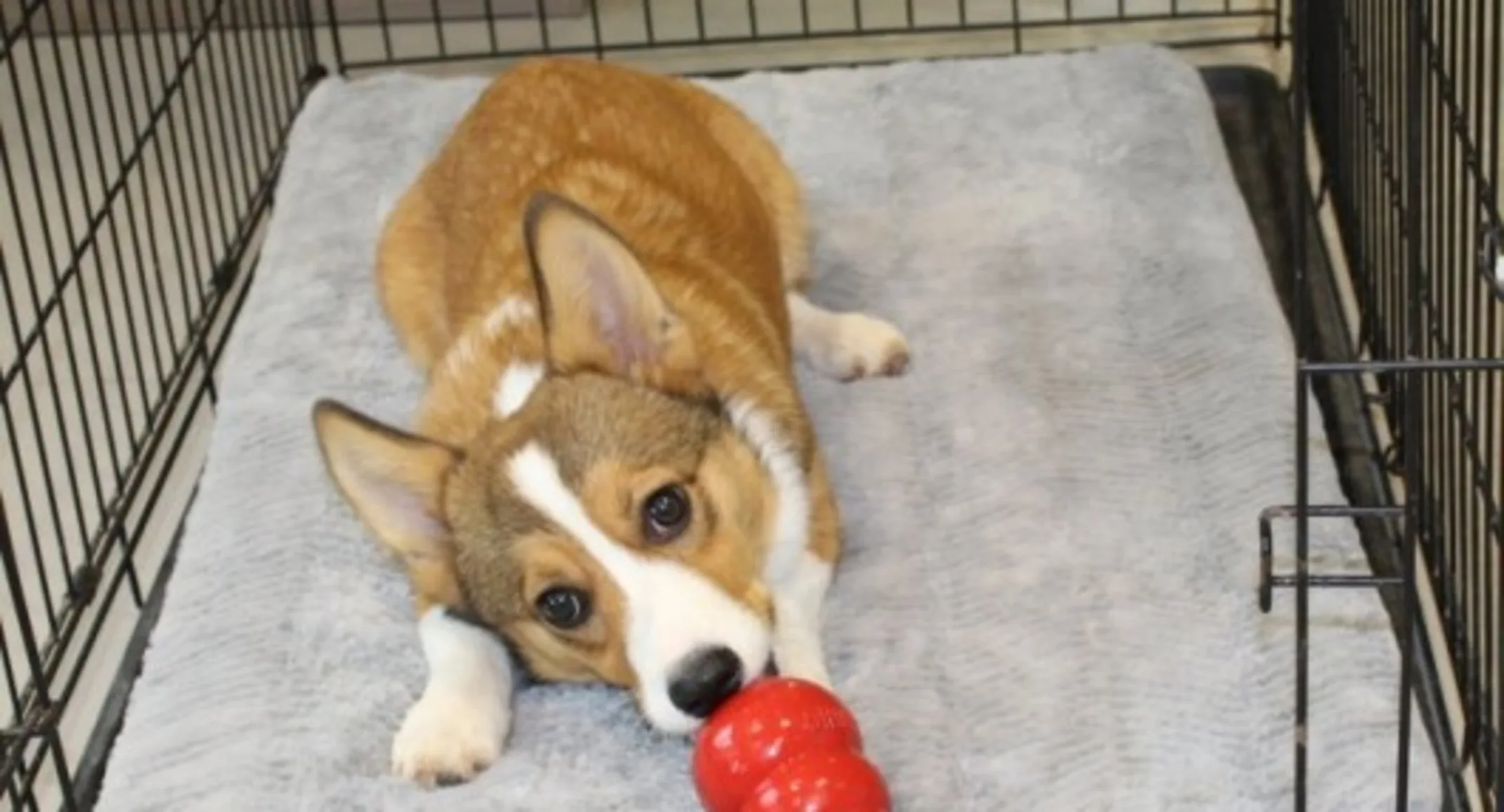A Step by Step Guide to Crate Training
Training Tips

Step One: Set yourself up for success
Choose the correct crate type
Not all crates are created equal and your dog may have an opinion on what they find most comfortable. The three main types of crates you typically see are wire, airline, and soft sided. Make sure you do a little research to decide what is best for your pup because there are pros and cons to each.
Wire crates- These are great because they breakdown easily, are easy to clean, and allow for a lot of airflow. One of the benefits of crates is cutting down on outside stimuli, and while seeing what is going on outside the crate may be comforting for some dogs, for others, the openness of the wire crate may increase whining, stress, and anxiety. This however can be easily combated by covering a few sides with a sheet or a thin blanket that allows for airflow, making this type a great choice for first time crate users.
Airline crates- These are hard plastic crates that offer a lot of durability and protection. They are great for dogs who prefer den-like spaces and can be a great choice for fearful dogs. They do not breakdown however and storage can be difficult.
Soft sided crates- These are very light and great for travel, however they are cloth so if your dog does have an accident, they are really difficult to clean. They are also easily destroyed and can be quite dangerous if your dog is not fully crate trained. Not a good starter crate.
Choose the correct size crate
It may seem counter intuitive, but having a crate that is too big can actually be a disadvantage in the training process. If it is too big a space, it may not have the den-like feel that some dogs desire. It also means that the crate becomes an ineffective potty training tool as many puppies will sleep in one corner of the crate and go potty in another. If the crate is too small, dogs may become stiff or simply not be comfortable. Dogs should be able to stand up, lay down, and turn around easily in the crate.
Helpful tip! For owners with growing puppies, some wire crates come with dividers so that you can slowly increase in crate size as the dog grows!
Create a Calming Environment
The crate should be a place where your dog can relax. If there is too much going on around them (such as kids running around) or the space is uncomfortable, your dog may feel overwhelmed or unsafe.
Make sure the crate is not in direct sunlight and is somewhere with a regulated temperature.
Make sure your pup's crate is not somewhere where loud noises will disrupt their rest, such as right next to the front door.
Spend some quiet time near the crate giving your puppy a relaxing massage, or play some relaxing music. There are even CDs made specifically to help dogs relax!
Step Two: Have a positive introduction to the crate
We mentioned in this post that dogs are going to have varying levels of natural comfort when it comes to crates. Some will absolutely LOVE it right away while others will take a little more training to teach them it is a safe space. Either way, the first introduction to the crate should be as positive as possible.
Helpful tip! Keep in mind that if your dog has not seen a crate before, it can look big and scary. It is also important to remember that some types of crate may move or make noise when dogs touch or step into them. This can be important to note for noise sensitive pups.
Step Three: slowly and incrementally increase time in the crate
We want to go slowly and make sure your dog is comfortable with each step before moving on to the next one. Many dogs will happily follow a treat into the crate, but start to feel anxious once the treat is gone or the door is closed. It is important not to get greedy and go too fast too soon because you can push your dog past their comfort point.
Helpful tip! If you have a young puppy or a dog who is not fully crate trained, make sure you get a dog walker to check in on your pup. If your dog is old enough, you may also want to explore taking your pup to daycare during the training process as to not inadvertently hinder progress by leaving your dog in the crate for longer than they are comfortable.
Toss a treat and allow your dog to go in to get it and come out again right away. Do not close the door.
Toss a few treats into the back of the crate and close the door while your dog eats the treats. Open the door and let them out immediately when the treats are gone.
Toss a few treats into the back of the crate and close the door. Keep the door closed for only a few seconds at a time and let them out before they start to whine or paw at the door.
Repeat the previous step, incrementally increasing how long the crate door is closed.
Once you are crating for a few seconds at a time, you can start giving a Kong or a longer lasting treat (provided it is not a choking hazard) and leave the door closed for longer periods of time.
Once your dog is happy being crated with a kong or similar toy, start helping them feel comfortable with you leaving the room for short periods of time. During the initial training process, it is important to return before the treat is finished so that they do not begin to wonder where you went.
Crate throughout the day for short periods of time, even when you are home. We don’t want to crate ONLY when we leave for hours at a time. Spending relaxing time in the crate should be a natural and stress free part of the dog’s daily routine.
Helpful tip! Feeding your dog’s meals in their crate is a great way to make it a really positive place.
Step Four: Add a verbal cue
It is important to always give your dog a choice to enter the crate on their own. Forcing them into the crate will not only show them that the crate is a negative place, it can also damage your relationship with the animal. Putting the crate on a verbal cue is fun and rewarding for both you and your dog.
Start by choosing your cue. Many use, “go to crate” but it can be anything you want! Just make sure to keep it consistent.
Say your selected cue, toss the treat, and praise with another treat once they enter. Make sure you are saying the cue immediately before the dog enters the crate
If your dog does not go into the crate, do not repeat the cue, just reset and start again.
For more advanced work, such as going to the crate on cue from a distance or even opening and closing the crate door, reach out to a trainer to help take you and your dog to the next level.
Helpful tip! Never say or yell the cue in anger. This should be a fun and positive experience. If you dog is reluctant to enter, you have gone too far too fast and need to go back a step.
Step Five: Regularly touch up on the basics
Even after your dog is comfortable being crated, it is important to touch up on the basics every now and again to check in on their comfort level. Dogs, just like people go through many developmental stages in their lives where they may begin to interpret their world differently. Just because your dog has been comfortable with something in the past, doesn’t necessarily mean that will be the case indefinitely.
